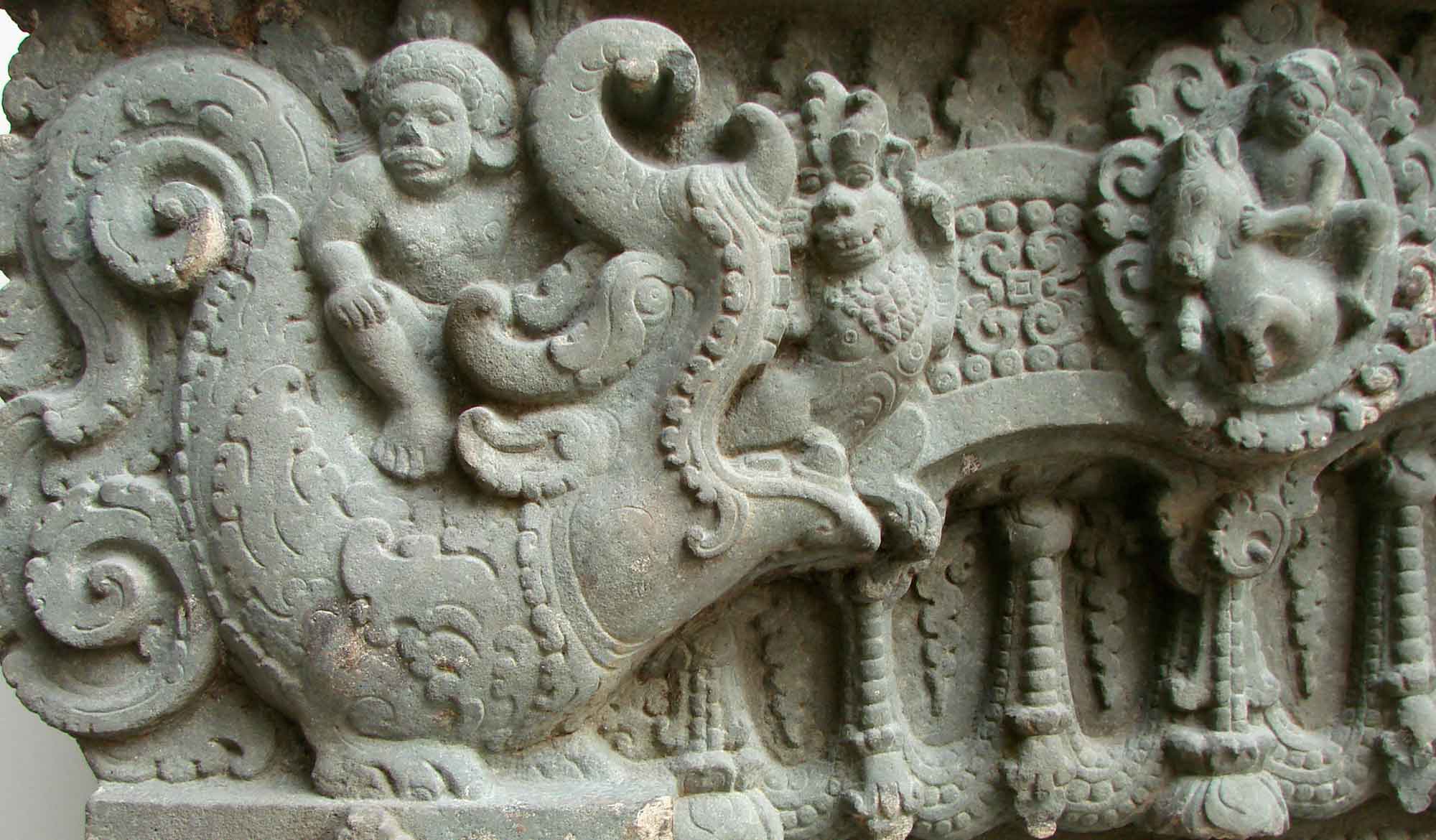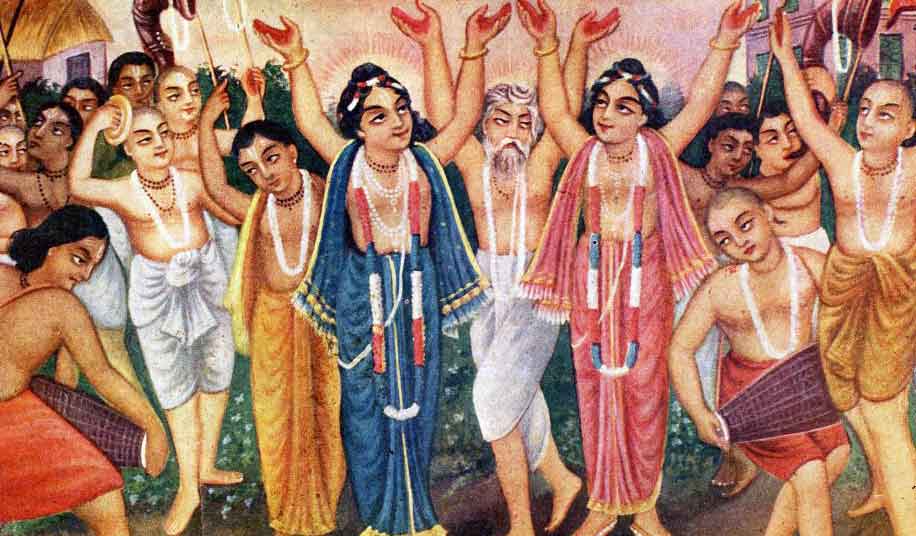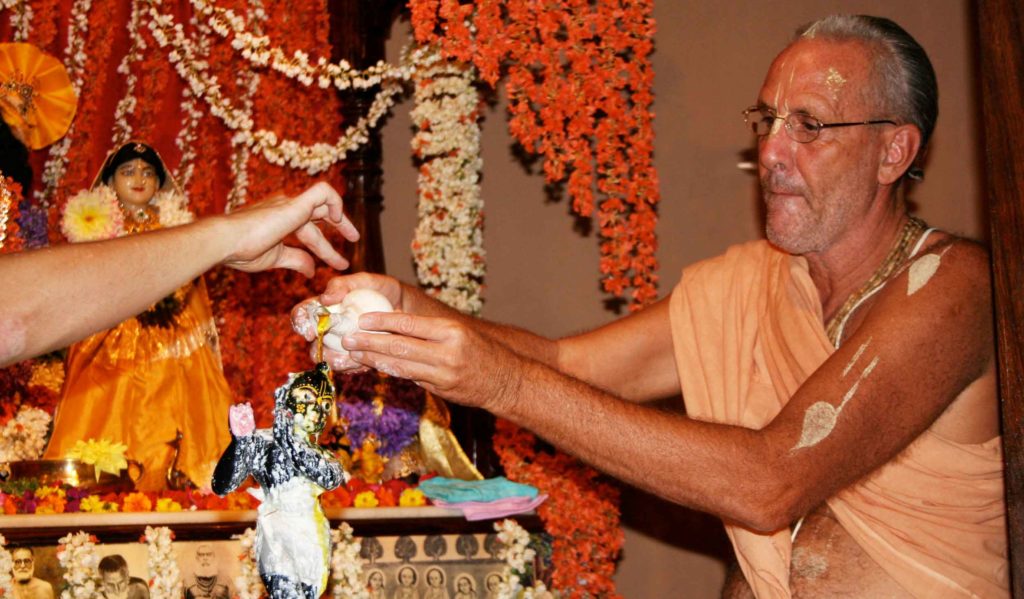Overview
“Makara - Myth or fact?” was written by Swami B.G. Narasingha in 2011. Mahārāja gives a history of the Makara in the Vedic literature, and makes a case for dinosaurs in the Śrīmad Bhāgavatam.
In Sanskrit ‘Makara’ is a word that means ‘sea dragon’ or ‘aquatic-monster,’ long thought to be a mythical creature in Hindu and Buddhist traditions. Paintings and sculptures of this fantastical creature are found in India, Nepal, Sri Lanka, Burma, Thailand, Cambodia, Malaysia, Indonesia, Vietnam, China and Japan — practically everywhere in Asia.
The Makara in India is known to be the vāhana (vehicle) of Gaṅgā Devī—the goddess of the river Ganges and the vāhana of the god of the sea, Varuṇa. A Makara is also the insignia of Kāmadeva (god of lust) and Kāmadeva’s flag is called makara-dhvaja, a flag having the Makara drawn on it. In Hindu astrology the Makara is also the astrological sign of Capricorn. A little research reveals this strange mythical creature to have been very popular both in ancient times and in our present day. But is it mythical?
The Makara is often depicted with the head of a crocodile, horns of a goat, the body of an antelope and a snake, the tail of a fish or peacock and the feet of a panther. Varuṇa is said to be the only one who can control the Makara and does not fear them (save and except for Kṛṣṇa, that is).
In some English translations of the Gītā, for simplicity of reading, ‘makara’ has been translated as shark. But it is not a shark. The Timiṅgila that is often mentioned along with the Makara in other Vedic texts is classified as a shark – a shark of monstrous proportions.
Mahābhārata mentions the Timiṅgila and Makara as being deep within the ocean, along with other huge sea creatures:
timiṅgilāḥ kacchapāś ca tathā timi-timiṅgilāḥ
makarāś cātra dṛśyante jale magnā ivādrayaḥ
“There were seen Timiṅgilas, tortoises, Timi-Timiṅgilas and Makaras, that were like great rocks submerged in the water.” (Mahābhārata, Vana-parva. 168.3)
The Ayurvedic text of the 6th Century BCE known as Suśruta Saṁhitā also lists the Timiṅgila and Makara as being amongst the formidable species of aquatic life:
timi-timiṅgila-kuliśa-pākamatsya-nirularu
nandi-vāralaka-makara-gargaraka-candraka
mahā-mīna-rājīva prabhṛtya samudrāḥ
“The Timi, Timiṅgila, Kulisha, Paka-matsya, Nirularu, Nandi-Vāralaka, Makara, Gargaraka, Candraka, Mahā-mīna, and Rājīva etc, constitute the family of marine fish.” (Śushruta Samhita, Chapter 45)
In Śrīmad Bhāgavatam, Makaras and Timiṅgila are mentioned as predators, attacking Markaṇḍeya Ṛṣi:
kṣut-tṛṭ-parīto makarais timiṅgilair
upadruto vīci-nabhasvatāhataḥ
tamasy apāre patito bhraman diśo
na veda khaṁ gāṁ ca pariśrameṣitaḥ
“Suffering from hunger and thirst, attacked by Makaras and Timiṅgila and battered by the waves and the wind, Markaṇḍeya wandered through the infinite gloom that enveloped him. Overcome by exhaustion, he lost all sense of direction and could not ascertain what was the sky and what was the earth.” (Bhāgavatam 12.9.16)
Bhagavad-gītā mentions the Makara in Verse 31, Chapter 10 as follows:
pavanaḥ pavatām asmi rāmaḥ śastra-bhṛtām aham
jhaṣāṇāṁ makaraś cāsmi srotasām asmi jāhnavī
“Of purifiers I am the wind. Of the wielders of weapons I am Rāma. Amongst aquatics I am the Makara and of rivers I am the Gaṅgā.”
The Makara is described in Vedic texts as half animal, half aquatic and an aggressor — a true monster of the deep. Often depicted in art as having the mouth of a crocodile, the body of a fish, the tail of a peacock and the paws of a panther, the Makara has attained mythical status.
Now the question arises – is the Makara a mythical creature or was it actually real? And if so, then how could it look like it has been depicted in art for centuries with so many different animal body parts? When one looks at recent scientific discoveries and takes into consideration a bit of ‘poetic license’ that the artist may have employed, the so-called mythical Makara becomes as real as life.
Recent discoveries in archaeology have revealed what palaeontologists call a Pliosaur. The fossilized Pliosaur was found in Dorset, England in 2003 and took until 2008 to remove from the rock cliff in which it was found. Once excavated it revealed a sea monster in remarkable detail.
Scientists suspect the Pliosaur fossil is approximately 155-million-years old and lived during the Jurassic and Cretaceous Periods during which time it was one of the top predators of the oceans.
Palaeontologist Richard Forrest commented to the BBC as follows: “This is an iconic specimen – one of the most exciting we have seen in years. It was probably the most fearsome predator that ever lived. Standing in front of the skull you can imagine this enormous beast staring straight back at you, fixing you with its binocular vision, and attacking. Just thinking about it raises the hairs on the back of your neck.”
Dr. Forrest went on to say that the creature’s bulky body, which would have been powered through the water with four paddle-like limbs, has never been found and may not have fossilized. Scientist’s estimate based on the 2.4meter long skull, that the Pliosaur would have been 15 to 18 meters in length. Impressive indeed.
We are herein suggesting that the Pliosaur could easily be the Makara of myth, but we are not the first to equate a mysterious ocean monster to the Makara. We have also stumbled upon the reports of a creature called the Ambulocetus, a creature that could walk as well as swim. It lived during the early Eocene Period some 50 million years ago. The fossil of Ambulocetus was found on the coast of Pakistan from a time when Pakistan and India was a single island in the Indian Ocean slowly drifting toward the continental shelf of Asia. Some crypto-zoologists speculate that the Ambulocetus is a candidate for being the Makara, yet most scientists suggest that the Ambulocetus fills the evolutionary gap between aquatics and land animals.
Once, when discussing with Puṣṭa-Kṛṣṇa, Śrīla Prabhupāda commented that there is no discussion of dinosaurs in the Vedas, therefore he did not believe that they existed. Then again, Sadāpūta recounts that when Prabhupāda was asked about the dinosaurs he replied that they were not extinct. So which is it? Is there really no mention of dinosaurs in the Vedas, or was Prabhupāda just denying scientific knowledge and discoveries because most scientists of his time were denying the Vedic knowledge? We think so.
In any case, we do find a reference to what easily could be understood to be dinosaurs in Śrīmad Bhāgavatam when demons and demigods rode strange creatures into battle.
gṛdhraiḥ kaṅkair bakair anye śyena-bhāsais timiṅgilaiḥ
śarabhair mahiṣaiḥ khaḍgair go-vṛṣair gavayāruṇaiḥ
śivābhir ākhubhiḥ kecit kṛkalāsaiḥ śaśair naraiḥ
bastair eke kṛṣṇa-sārair haṁsair anye ca sūkaraiḥ
anye jala-sthala-khagaiḥ sattvair vikṛta-vigrahaiḥ
senayor ubhayo rājan viviśus te’grato’grataḥ
“O King, some soldiers fought on the backs of vultures, eagles, ducks, hawks and bhāsa birds. Some fought on the backs of Timiṅgilas, which can devour huge whales, some on the backs of Śarabhas, and some on buffalo, rhinoceroses, cows, bulls, gavayā (jungle cows) and aruṇas. Others fought on the backs of jackals, rats, kṛkalāsa, rabbits, human beings, goats, black deer, swans and boars. In this way, mounted on animals of the water, land and sky, including animals with deformed bodies (vikṛta-vigraha), both armies faced each other and went forward.” (Bhāgavatam 8.10.10-12)
Here we find a fantastical description of the vāhanas used in a great battle in horary antiquity, but some of the creatures described have no English or Indo-Aryan equivalent such as bhasa, sharabhas, Timiṅgila, gavayā, aruṇas, kṛkālasa and vikṛta-vigraha. So what are these creatures and why do they have no equivalent names in modern languages? Could they be extinct? Could any of these have been what we now call dinosaurs? We think so. The mere fact that the Timiṅgila is mentioned is proof enough that some of these creatures are going to be formidable predators – which ones?
Vikṛta-vigraha translates as ‘animals with deformed bodies’ and kṛkālasa translates as ‘big lizard’. So when one’s opponent is riding a vicious animal like a rhinoceros or a Timiṅgila — then is riding an ordinary lizard into battle a good idea, even a big one? Kṛkālasa is a ‘big lizard’ — think dinosaur! And vikṛta-vigraha are ‘animals with deformed bodies’ — think dinosaur! In any case, no vāhana mentioned here could have been ordinary, – even the human vāhanas must have been giants. So it is intelligent to think that if one takes these narratives to be true in the first place, then what we think of today as dinosaurs could surely be among the vāhanas mentioned in Śrīmad Bhāgavatam.
The gavayā mentioned in the above verse translates as ‘jungle cow’ and interestingly enough these ‘jungle cows’ (also known in modern Hindi as nīlgāya, blue cows) still exist in and around Vṛndāvana, India and, like the Makara, they have the distinct characteristic of three animals — a cow, a horse and a deer. Once seeing these strange animals there is no argument that they are a ‘three in one’ creature. So why not a Makara with a mouth of a crocodile, a body of a fish, and a tail of a peacock? You just haven’t seen one yet. But it looks like the archaeologists in England are on to something with their recent discovery of the Pliosaur.
It is true that the kṛkālasa and bhāsa are not easily equated with Tyrannosaurus Rex and Pterodactyl, but then again, why not? It seems to be a matter of putting one and one together and moving on.
Yes – there were dinosaurs mentioned in Śrīmad Bhāgavatam and possibly other places in the vast Vedic literature. Unfortunately, it has been the thinking of some theists that the scientists have falsified dinosaur remains (“The Devil put them there”) simply to give credit to the evolutionary theory. But I think it is safe to say that such does not stand against the repeated discoveries of dinosaurs in different parts of the world and even in India.
Yes, dinosaur remains and even dinosaur eggs have been discovered in Gujarat, India. However, when the fossilized eggs were first discovered, villagers took them home and began worshiping them as śiva-liṅgams.
When it is obvious that scientists are not running around falsifying dinosaur fossils and that dinosaurs did indeed exist in India, then it is reasonable to conclude that dinosaurs are indeed mentioned in Vedic literature and that archaeologists may have recently found the Makara in the fossil record in England.
Admittedly, the case for the Megalodon fossil being the Timiṅgila as discussed in our previous article may be more convincing than that of the Pliosaur fossil being the Makara, but the later is certainly probable. Thus, it is worth reiterating a previous point regarding the age of man.
According to scientific evidence, it is estimated that the last of the Pliosaur and Megalodons lived on this planet around 1.5 million years ago or before. That is a long time ago, especially considering that the estimated age (according to science) of the first human being was only 250,000 years ago. That would mean that the Pliosaur and Megalodon became extinct 1,250,000 years before the first human being spoke a coherent language, kept records or attempted to write anything.
The Pliosaur and the Megalodon appear to be the same creatures as the Makara and the Timiṅgila mentioned in Vedic texts. But what is so amazing or interesting about that, and what is our point?
Our point is that western scholars assert that the Bhāgavatam was only written in the 9th Century CE, the Ramayana in the 4th Century BCE, and the Mahābhārata between the 8th and 4th centuries BCE. But if this were a fact, then how did the writers of these books know about ocean-dwelling creatures, their size, their vicious aggression and their diets if those creatures had already been extinct for 1.5 million years? Bhāgavatam, Rāmāyaṇa and Mahābhārata all mention the existence of the Makara/Pliosaur and the Timiṅgila/Megalodon, but where did the authors get their information?
When (by scientific estimation) human beings have only been on this planet since 1,250,000 years after the Megalodon/Timiṅgila became extinct — who told the Vedic authors about these creatures? If there were no humans present on this planet between the period when the Pliosaur and Megalodon became extinct and 250,000 years ago, how could the writers of the Vedic texts have known such things? And it is obvious that they did.
Scientists and scholars will have to ponder this question, but for us it is simple — there have always been human beings on this planet from its earliest beginnings and the knowledge of all such things has been passed down thru the ages via the disciplic succession of gurus and disciples.
Related Articles & Books
- 📖 When Wise Men Speak Wise Men Listen by Swami B.G. Narasiṅgha Mahārāja (Book)
- Vedic Global Civilisation by Śrīla Bhakti Gaurava Narasiṅgha Mahārāja
- UFOs – Is Anyone Out There? by Śrīla Bhakti Gaurava Narasiṅgha Mahārāja
- Modern Science and the Vedas by Śrīla Bhakti Gaurava Narasiṅgha Mahārāja
- Giants – Myth or Fact? by Śrīla Bhakti Gaurava Narasiṅgha Mahārāja
- Timiṅgila – Myth or Fact? by Śrīla Bhakti Gaurava Narasiṅgha Mahārāja
- Makara – Myth or fact? by Śrīla Bhakti Gaurava Narasiṅgha Mahārāja
- Lost Ancient Technology by Kalki Dāsa
- Here Be Dragons! by Kalki Dāsa
- The Great Flood – Are Manu and Noah the Same Person? by Kalki Dāsa
- Zarathustra and The De-evolution of Theism by Kalki Dāsa
- Did Darwin Borrow His Theory of Evolution from the Vedas? by Kalki Dāsa
Further Reading
Prema Dhāma Deva Stotram with the Narasiṅgha Sevaka Commentary – Verses 61-65
In verses 61 to 65 of 'Prema Dhāma Deva Stotram', Śrīla Śrīdhara Mahārāja narrates the pastime of Śrī Caitanya at Caṭaka Parvata In Purī and explains how the scriptures produced by Brahmā and Śiva are ultimately searching for the personality of Mahāprabhu who is merciful too all jīvas, no matter what their social position.
Prabhupāda Śrīla Sarasvatī Ṭhākura’s Visit to Ayodhyā
With the forthcoming observance of Śrī Rāma Navamī, we present 'Prabhupāda Śrīla Sarasvatī Ṭhākura’s Visit to Ayodhyā' written by Śrīla Bhaktisiddhānta Sarasvatī Ṭhākura Prabhupāda from The Gaudīyā magazine, Vol 3. Issue 21/ In December 1924, after visiting Benares and Prāyāga, Sarasvatī Ṭhākura visited the birth-site of Śrī Rāmācandra in Ayodhyā.
Śaraṇāgati – The Only Path to Auspiciousness
In this article, 'Śaraṇāgati - The Only Path to Auspiciousness', Dhīra Lalitā Dāsī analyses the process of śaraṇāgati (surrender) beginning with śraddhā (faith). She also discusses the role of śāstra and the Vaiṣṇava in connection with surrender.
Ātma Samīkṣā – The Value of Introspection
In this article, "Ātma Samīkṣā – The Value of Introspection" Kalki Dāsa highlights the importance of introspection in the life of a devotee and especially in relation to the worldly environment that surrounds us. He also explains how transcendental sound influences our capacity to introspect.
Prema Dhāma Deva Stotram with the Narasiṅgha Sevaka Commentary – Verses 61-65
In verses 61 to 65 of 'Prema Dhāma Deva Stotram', Śrīla Śrīdhara Mahārāja narrates the pastime of Śrī Caitanya at Caṭaka Parvata In Purī and explains how the scriptures produced by Brahmā and Śiva are ultimately searching for the personality of Mahāprabhu who is merciful too all jīvas, no matter what their social position.
Prabhupāda Śrīla Sarasvatī Ṭhākura’s Visit to Ayodhyā
With the forthcoming observance of Śrī Rāma Navamī, we present 'Prabhupāda Śrīla Sarasvatī Ṭhākura’s Visit to Ayodhyā' written by Śrīla Bhaktisiddhānta Sarasvatī Ṭhākura Prabhupāda from The Gaudīyā magazine, Vol 3. Issue 21/ In December 1924, after visiting Benares and Prāyāga, Sarasvatī Ṭhākura visited the birth-site of Śrī Rāmācandra in Ayodhyā.
Śaraṇāgati – The Only Path to Auspiciousness
In this article, 'Śaraṇāgati - The Only Path to Auspiciousness', Dhīra Lalitā Dāsī analyses the process of śaraṇāgati (surrender) beginning with śraddhā (faith). She also discusses the role of śāstra and the Vaiṣṇava in connection with surrender.
Ātma Samīkṣā – The Value of Introspection
In this article, "Ātma Samīkṣā – The Value of Introspection" Kalki Dāsa highlights the importance of introspection in the life of a devotee and especially in relation to the worldly environment that surrounds us. He also explains how transcendental sound influences our capacity to introspect.








